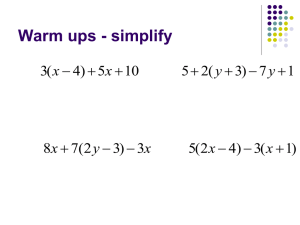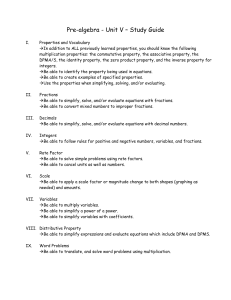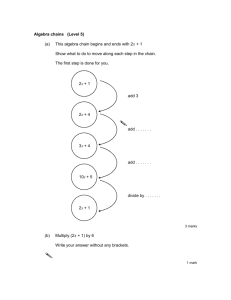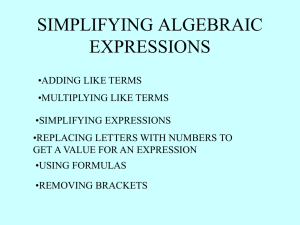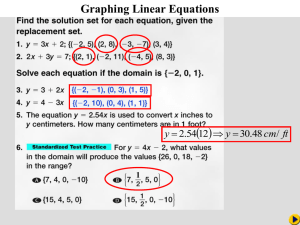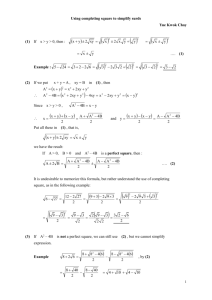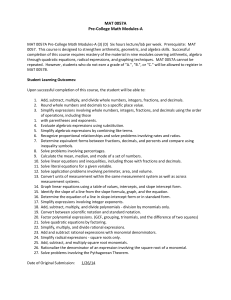doc
advertisement
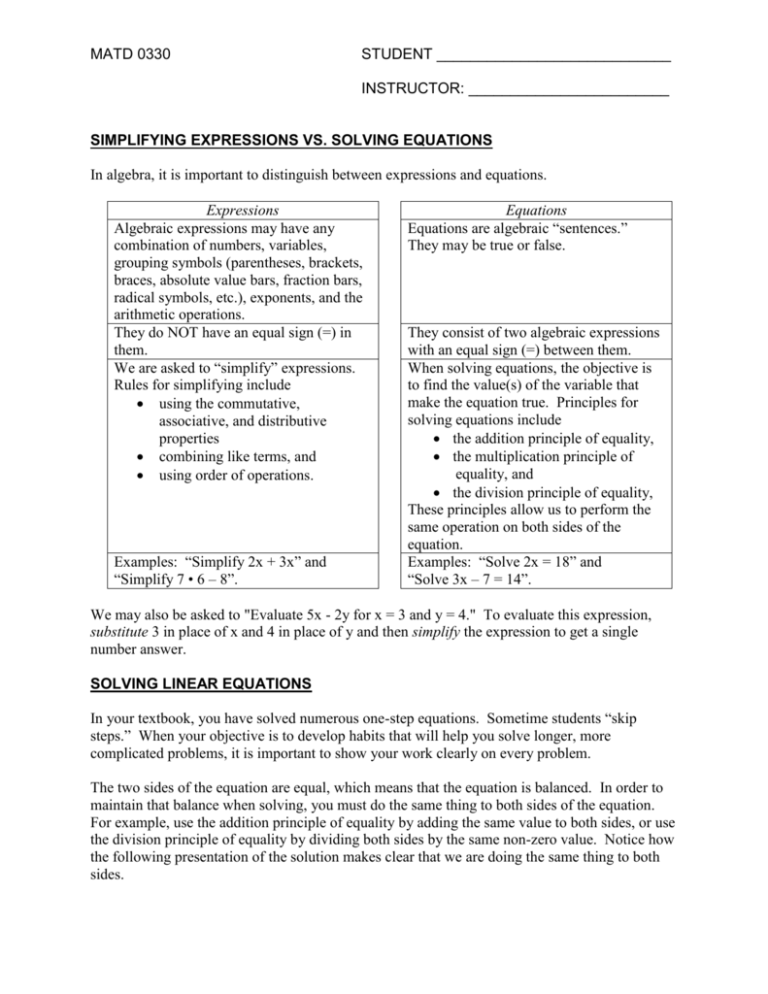
MATD 0330 STUDENT ____________________________ INSTRUCTOR: ________________________ SIMPLIFYING EXPRESSIONS VS. SOLVING EQUATIONS In algebra, it is important to distinguish between expressions and equations. Expressions Algebraic expressions may have any combination of numbers, variables, grouping symbols (parentheses, brackets, braces, absolute value bars, fraction bars, radical symbols, etc.), exponents, and the arithmetic operations. They do NOT have an equal sign (=) in them. We are asked to “simplify” expressions. Rules for simplifying include using the commutative, associative, and distributive properties combining like terms, and using order of operations. Examples: “Simplify 2x + 3x” and “Simplify 7 • 6 – 8”. Equations Equations are algebraic “sentences.” They may be true or false. They consist of two algebraic expressions with an equal sign (=) between them. When solving equations, the objective is to find the value(s) of the variable that make the equation true. Principles for solving equations include the addition principle of equality, the multiplication principle of equality, and the division principle of equality, These principles allow us to perform the same operation on both sides of the equation. Examples: “Solve 2x = 18” and “Solve 3x – 7 = 14”. We may also be asked to "Evaluate 5x - 2y for x = 3 and y = 4." To evaluate this expression, substitute 3 in place of x and 4 in place of y and then simplify the expression to get a single number answer. SOLVING LINEAR EQUATIONS In your textbook, you have solved numerous one-step equations. Sometime students “skip steps.” When your objective is to develop habits that will help you solve longer, more complicated problems, it is important to show your work clearly on every problem. The two sides of the equation are equal, which means that the equation is balanced. In order to maintain that balance when solving, you must do the same thing to both sides of the equation. For example, use the addition principle of equality by adding the same value to both sides, or use the division principle of equality by dividing both sides by the same non-zero value. Notice how the following presentation of the solution makes clear that we are doing the same thing to both sides. SIMPLIFYING EXPRESSIONS AND SOLVING EQUATIONS MATD 0330 2 Example 1: Solve x + 17 = 48. Solution: x + 17 = 48 x + 17 – 17 = 48 – 17 x + 0 = 31 x = 31 Subtract 17 from both sides. Notice where you get 0. Use the fact that anything plus zero is itself. Check your solution: The point of solving an equation is to find a value for the variable that makes the equation true. So when you find a solution, you can check it to be sure that it does make the sentence true. Substitute your solution into the original equation, evaluate (or simplify) both sides, and verify that the two sides are equal. Example 2: Check the solution you found in Example 1. Check: x + 17 = 48 ( ) + 17 ? 48 (31) + 17 ? 48 31 + 17 ? 48 48 ? 48 48 = 48 It checks! Replace the variable with parentheses and the equal sign with a question mark. Substitute the solution you found into the parentheses. Do the indicated operations. Do the indicated operations. Decide whether it is correct to replace the question mark with an equal sign. Simplify the sides first: Some equations require you to simplify before applying equationsolving principles. You may need to simplify one side or the other, or both sides. Remember that the objective is to isolate the variable, which means to get it on one side of the equation by itself. Example 3: Solve 3x = 8 • 6 – 9 Solution: 3x = 8 • 6 – 9 3x = 48 – 9 3x = 39 3x 39 = 3 3 x = 13 The expression on the right-hand side is one we can simplify using order of operations. Do that one step at a time. Continue simplifying the right-hand side. Divide both sides by 3. Simplify the expressions on both sides. Example 4: Solve 12x – 8x = 44 Solution: 12x – 8x = 44 4x = 44 4x 44 = 4 4 x = 11 The expression on the left-hand side must be simplified. Combine like terms. Divide both sides by 4. Simplify the expressions on both sides. SIMPLIFYING EXPRESSIONS AND SOLVING EQUATIONS MATD 0330 3 Example 5: Solve 72 – 6 • 7 = 4x – x Solution: 72 – 6 • 7 = 4x – x 72 – 42 = 4x – 1x 30 = 3x 30 3x = 3 3 10 = x Both sides must be simplified. We can do one step on each side at the same time. Do the first step on each side. Do the second step on each side. Divide both sides by 3. Simplify the expressions on each side. Note that this answer is equivalent to x = 10. When checking solutions, it is important to substitute the solution into the original problem. Substituting it into a later step does not check whether the earlier steps were done correctly. Example 6: Check your solution to Example 5. Check: 72 – 6 • 7 = 4x – x 72 – 6 • 7 ? 4 • ( ) – ( ) 72 – 42 ? 4 • (10) – (10) 30 ? 40 – 10 30 ? 30 30 = 30 Parentheses replace the variable and ? replaces =. Put in the solution. Simplify both sides, one step each at a time. Decide whether it is correct to replace ? with =. If both sides are the same, then make the replacement. It checks! Review: Some steps used to solve linear equations follow. The steps should always be done in the order given, but some problems may require only one or two of the steps instead of all three. Remember that the objective is to "isolate the variable" in order to find the value of the variable that makes the equation true. To move something away from the variable, use the opposite operation. For example, if it is added, subtract it from both sides or if it is multiplied, divide both sides by it. Also, please remember to show your steps so that when you do the more difficult problems, you will know what to do. 1. If possible, simplify the algebraic expressions in the equation. This means that you should remove any grouping symbols and combine like terms on single sides of the equation. Usually, simplify completely on each side individually before doing anything to both sides. 2. Move every term containing the variable to one side of the equation and every term without the variable to the other side of the equation. To do this, add or subtract the same term to or from both sides of the equation. Then simplify each side of the equation again. 3. Multiply or divide both sides of the equation by the same non-zero number. This non-zero number is the coefficient of the variable which means it is the number that is "attached" to the variable by either multiplication or division. Simplify each side of the equation again. While solving, except when simplifying single sides of the equation, remember that if you do something to one side, do the same thing to the other side. This will keep the equation balanced. SIMPLIFYING EXPRESSIONS AND SOLVING EQUATIONS MATD 0330 4 Example 7: Solve 5 + 3x = 41 Solution: 5 + 3x = 41 5 + 3x – 5 = 41 – 5 0 + 3x = 36 3x = 36 3x 36 = 3 3 x = 12 Neither side of the equation can be simplified. Subtract 5 from both sides in order to isolate the term 3x. Simplify the expressions on each side. Simplify. Use the fact that zero plus any value is itself. Divide both sides by 3. Simplify each side again. How to start: In 5 + 3x = 41, you need to subtract 5 and also divide by 3 in order to isolate the x. How did we decide which to do first? When performing the same operation on both sides of the equation, we always do the addition and subtraction before the multiplication and division. We subtracted 5 instead of 41 because we want to isolate the 3x. We needed to move the 5 away from it to the other side of the equation. How the problems are written: Notice that the following four are all the same equation, so they should all be solved by exactly the same method. See the solution above. 5 + 3x = 41 3x + 5 = 41 41 = 3x + 5 41 = 5 + 3x In each of these cases, the problem is solved by subtracting 5 from both sides first, and then dividing both sides by 3. Example 8: Solve 59 = 7x – 18 Solution: 59 = 7x – 18 59 + 18 = 7x – 18 + 18 77 = 7x + 0 77 = 7x 77 7x = 7 7 11 = x Neither side of the equation can be simplified. Add 18 to both sides in order to isolate the term 7x. Simplify each side. Simplify. Use the fact that any value plus zero is itself. Divide both sides by 7. Simplify each side again. Note that this answer is equivalent to x = 11. Example 9: Solve 5x = 3x + 18 Solution: 5x = 3x + 18 5x – 3x = 3x + 18 – 3x 2x = 18 + 0x 2x = 18 2x 18 = 2 2 x = 9 Neither side of the equation can be simplified. In order to move all terms with x to one side of the equation and non-variable (constant) terms to the other side, subtract 3x from both sides. Simplify each side. Notice that 3x – 3x = 0x or just 0. Simplify. Use the fact that any value plus 0x (or 0) is itself. Divide both sides by the coefficient of x. Simplify each side again. SIMPLIFYING EXPRESSIONS AND SOLVING EQUATIONS MATD 0330 5 Example 10: Solve 3x – 9 = 10x + 12 Solution: 3x – 9 = 10x + 12 3x – 9 – 3x = 10x + 12 – 3x 0x – 9 = 7x + 12 – 9 = 7x + 12 – 9 – 12 = 7x + 12 – 12 –21 = 7x + 0 –21 = 7x 21 7x = 7 7 –3 = x Neither side of the equation can be simplified. In order to move all terms with x to one side of the equation, subtract 3x from both sides. Simplify each side. Notice that 3x – 3x = 0x or just 0. Simplify. Use the fact that 0x (or 0) plus any value is itself. In order to move all non-variable (constant) terms to one side of the equation, subtract 12 from both sides. Simplify each side again. Simplify. Use the fact that any value plus zero is itself. Divide both sides by the coefficient of x. Simplify each side again. In the example above, we chose to move the variables to the right side of the equation in order to have a positive coefficient (7) of x. However, it does not matter which side you choose to move the variables. You do need to always move the constants to the other side. If you moved the variables and constants to different sides than in the example above, then the signs would be different but the answer would be the same. This is always true. In this example, you would have gotten –7x = 21. Then when you divide both sides by –7 (the coefficient of x), you still get the same answer: x = –3. One other important note: with practice, you may be able to omit the steps with the 0x and 0. Example 11: Solve 2(4x + 9) – (6 – x) = 17 – 4(3 – 5x) Solution: 2(4x + 9) – (6 – x) = 17 – 4(3 – 5x) 8x + 18 – 6 + x = 17 – 12 + 20x Simplify each side. Distribute the 2 through the first parentheses, the minus (implied –1) through the second parentheses, and the –4 through the third parentheses. Remember that when you distribute a negative, it changes the sign of every term in the parentheses. Notice that the most common mistake is to subtract 17 – 4 and then distribute to the third parentheses. However, multiplication (the distributing) is done before the subtraction in 17 – 4. 9x + 12 = 20x + 5 Combine like terms on each side. 9x + 12 – 20x = 20x + 5 – 20x Move the 20x by subtracting it from both sides. It would also be fine to move the 9x instead. The goal is to move all variable terms to one side and all constants to the other side. –11x + 12 = 0x + 5 Simplify each side. SIMPLIFYING EXPRESSIONS AND SOLVING EQUATIONS MATD 0330 –11x + 12 = 5 –11x + 12 – 12 = 5 – 12 6 Simplify. Any value plus 0x is itself. Move the constants to the opposite side from the variables. In this case, move the 12 by subtracting it from both sides. Simplify each side again. Simplify. Any value plus zero is itself. –11x + 0 = –7 –11x = –7 11x 7 = 11 11 7 x = 11 Divide both sides by –11, the coefficient of x. A negative divided by a negative is a positive. The fraction 7/11 is the exact (correct) answer. Always give an exact answer whenever possible. Do not give a rounded decimal answer unless the original problem has decimals. Example 12: Solve 3.45(6.1x – 0.3) = 18.9 Solution: 3.45(6.1x – 0.3) = 18.9 3.45 • 6.1x – 3.45 • 0.3 = 18.9 21.045x – 1.035 = 18.9 21.045x – 1.035 + 1.035 = 18.9 + 1.035 21.045x = 19.935 21.045x 19.935 = 21.045 21.045 x 0.947256 Example 13: Solve 62 = x • 120 62 = x • 120 62 = 120x 62 120x = 120 120 31 =x 60 0.51666666... = x 0.517 x Use the distributive law. Multiply. Add the same thing to both sides. Simplify each side. Divide both sides by the coefficient of x. For the final answer, round to as many places as indicated. If nothing is said about how many places to round to, use at least three decimal places. Here, we used six decimal places. Note that the symbol means "is approximately equal to." Round the result to three decimal places. Solution: Simplify the right side of the equation. Divide both sides by the coefficient of x. Reduce (simplify). This is the exact answer. Divide to get the decimal answer. Round the answer to 3 digits to the right of the decimal. Note that this answer is the same as x 0.517 There are two equivalent ways to write terms with fractional coefficients. The following two examples illustrate this. SIMPLIFYING EXPRESSIONS AND SOLVING EQUATIONS MATD 0330 7 3x 3 means x 8 8 y 1 means y Example 15: 4 4 Example 14: Example 16: Solve x 3 7 . 2 4 8 x 3 7 2 4 8 x 3 3 7 3 2 4 4 8 4 x 7 6 0 2 8 8 1 1 x 2 8 1 1 2 x2 2 8 Solution: Subtract the same constant from both sides. Simplify, including get a common denominator. Simplify each side. Divide both sides by 1/2, the coefficient of x. This is the same as multiplying both sides by the reciprocal of 1/2. The reciprocal is the fraction inverted (flipped over.) In this case, it is 2/1, which simplifies to 2. 2 2 x 2 8 1 x 4 Example 17: Solve Solution: Do the multiplication. Simplify. x 3x 8 5 10 x 3x 8 5 10 1 3 x x8 5 10 2 3 x x8 10 10 5 x8 10 1 x8 2 1 2 x28 2 x = 16 Clarify the fraction notation. Convert to a common denominator. Combine like terms. Reduce (simplify) the fraction. Multiply both sides by reciprocal of 1/2, the coefficient. Simplify each side. SIMPLIFYING EXPRESSIONS AND SOLVING EQUATIONS MATD 0330 Example 18: Solve Solution: 8 5 1 7 2 x 6 5 12 5 1 7 2 x 6 5 12 5 5 1 7 2x 6 6 5 12 10 1 7 x 6 6 12 10 1 1 7 1 x 6 6 6 12 6 10 7 1 x 6 12 6 10 7 2 x 6 12 12 10 9 x 6 12 5 3 x 3 4 3 5 3 3 x 5 3 5 4 Use distributive law. Simplify the left side. Add the same thing to both sides. Simplify each side. Convert to a common denominator. Combine like terms on the right side. Reduce fractions. Multiply both sides by the reciprocal of the coefficient of x. 9 x 20 Multiply and simplify. Clear fractions from equations: There is another way to solve equations containing fractions. Try both ways, and use whichever method works best for you. The alternate method is called "clearing the equation of fractions." It is very important that you use this method only for solving equations and not for simplifying expressions. To use the method properly, you must multiply both sides of the equation by the same non-zero number so that the equation will still be balanced. If you do this to an expression, you will change the value of the expression. To clear the fractions from an equation, first find the LCD (lowest common denominator) of all fractions in the equation. Then multiply both sides of the equation by that LCD. Remember that you must multiply both sides by the same LCD. A common mistake is to multiply each side by the LCD of that side. If you multiply each side by different LCDs, then the equation will no longer be balanced. SIMPLIFYING EXPRESSIONS AND SOLVING EQUATIONS MATD 0330 Example 19: Solve Solution: 9 x 3 7 2 4 8 x 3 7 2 4 8 Notice that there are three denominators in this problem: 2, 4, and 8. The LCD of these is 8. So we choose to multiply through both sides by 8. Be aware that you may also multiply through by any multiple of the LCD. The multiples of 8 are 8, 16, 24, 32, 40, 48, 56, 64, 72, 80, ... In other words, you may multiply through by any common denominator, not just the lowest one. This means that you could just multiply all of the denominators. For example, since 2 4 8 64 , you could multiply both sides by 64 and still eliminate the fractions. 7 x 3 8 8 Multiply both sides by the LCD. 8 2 4 x 3 7 8 8 8 Use the distributive law. 2 4 8 8x 8 3 8 7 Multiply. 2 4 8 4x + 6 = 7 No fractions remain because we multiplied through by the LCD. 4x + 6 – 6 = 7 – 6 Subtract the same number from both sides. 4x = 1 Simplify each side. 4x 1 Divide both sides by the coefficient of x. 4 4 1 x Simplify. 4 Example 20: Solve x 3x 8 5 10 Solution: Here the LCD is 10. Even though the right-hand side does not have a fraction, it is very important to multiply both sides of the equation by the same number. This keeps the equation balanced. x 3x 10 10 8 5 10 x 3x 10 10 10 8 5 10 10 x 10 3 x 80 5 10 2 Multiply both sides by the LCD. Use the distributive law. Multiply. 1 10 x 10 3x 80 5 10 Reduce (simplify) each fraction. SIMPLIFYING EXPRESSIONS AND SOLVING EQUATIONS MATD 0330 2 x 3 x 80 5x = 80 5 x 80 5 5 x = 16 Example 21: Solve 10 No fractions remain because we multiplied through by the LCD. Combine like terms. Divide both sides by the coefficient. Simplify. 5 1 7 2 x 6 5 12 5 1 7 2 x 6 5 12 Here the denominators are 6, 5, and 12, so the LCD is 60. We could immediately multiply through both sides by 60, but many students make mistakes doing that. Instead, we will use the distributive law to eliminate the parentheses first and then multiply both sides of the resulting equation by 60. 5 2x 5 1 7 Use the distributive law. 6 1 6 5 12 10 x 5 7 Multiply. 6 30 12 10 x 5 7 60 60 Multiply both sides by the LCD. 30 6 12 10 x 5 7 60 60 60 Use the distributive law. 6 30 12 600 x 300 420 Multiply. 6 30 12 100x – 10 = 35 Now we have an equation with no fractions. 100x – 10 + 10 = 35 + 10 Add the same number to both sides. 100x = 45 Combine like terms. 100 x 45 Divide both sides by the coefficient. 100 100 9 x Simplify. 20 Solution: SIMPLIFYING EXPRESSIONS AND SOLVING EQUATIONS MATD 0330 11 When to “Cross-multiply”: Recall that proportions are equations that are a single fraction equal to another single fraction. You learned to cross-multiply to solve proportions. Look at the example below. On the left it is done by cross-multiplying and on the right by multiplying through by a common denominator. Notice that the two methods are equivalent. This demonstrates that the method of cross-multiplying is just a special case of multiplying both sides by the common denominator. Example 22: Solve 4 12 x 27 Method of cross-multiplying 4 12 x 27 4 27 12 x 4 27 12 x 12 12 9 = x Method of multiplying by the common denominator The common denominator is 27 times x, or simplified 27x. 4 12 x 27 4 12 27 x 27 x Multiply both sides by LCD. x 27 27 x 4 27 x 12 x 27 27 4 12 x Notice that the denominators cancel. 27 4 x 12 12 12 9 = x Reduce (simplify.) SIMPLIFYING EXPRESSIONS AND SOLVING EQUATIONS MATD 0330 12 Work the following problems: Rewrite each of the following four fractions in the other form. 7c 5 m 1. 2. 3. x 15 9 12 4. 1 n 7 In the following four problems, indicate whether the word “simplify” or “solve” would be given for a problem like this. Then work each problem. 5. 4 • 5 + 7 • 10 6. 12 = 5x + x 7. 4x + x 8. 4 • 5 + 7 • 10 = 4x + x Simplify each of the following expressions. 9. 10. 11. 12. –5(9x) 3(x – 4) – (17x – 30) –4(6 + 5x) Solve each of the following equations. Check your solution for at least five problems. 13. 14. 15. 16. 17. 18. 19. 20. 21. 22. 23. 24. 25. 26. 27. 28. 29. 30. 4(x – 5) = 36 2(4x) = 72 –7(4 – 3x) = –91 –8(2x + 3) = 56 2x – 12 = 5x 6x + 12 = 10x + 4 6(2x + 1) – 7x = 41 2(x – 7) + 4 = 10 6(4 – 3x) + 8x = x – (8x – 3) 5 + 10x + 31 = – 8 – 4(3x) 4(x – 3) = 6(2x + 7) 12(2x + 1) = 10 – 5(6 – x) y 1 11 6 3 24 7w 1 7 12 2 18 9.2(2x – 0.3) = 4.1 Round your answer to three decimal places. 8.3 + 2.5y =12.2 1 1 7 3 x 4 5 10 7w 7 1 1 8 4 12 6 SIMPLIFYING EXPRESSIONS AND SOLVING EQUATIONS MATD 0330 ANSWERS: 1. 7 c 15 2. 1 m 12 3. 5x 9 n 4. 7 21. x = 7 22. x = –2 23. x = –27/4 24. x = –32/19 25. y = 3/4 26. w = 32/21 5. “Simplify” and 90 27. x 0.373 6. “Solve” and x = 2 28. y = 1.56 7. “Simplify” and 5x 29. x = 1 8. “Solve” and x = 18 30. w = 3 9. –45x 10. 3x – 12 11. –17x + 30 12. –24 – 20x 13. x = 14 14. x = 9 15. x = –3 16. x = –5 17. x = –4 18. x = 2 19. x = 7 20. x = 10 13
